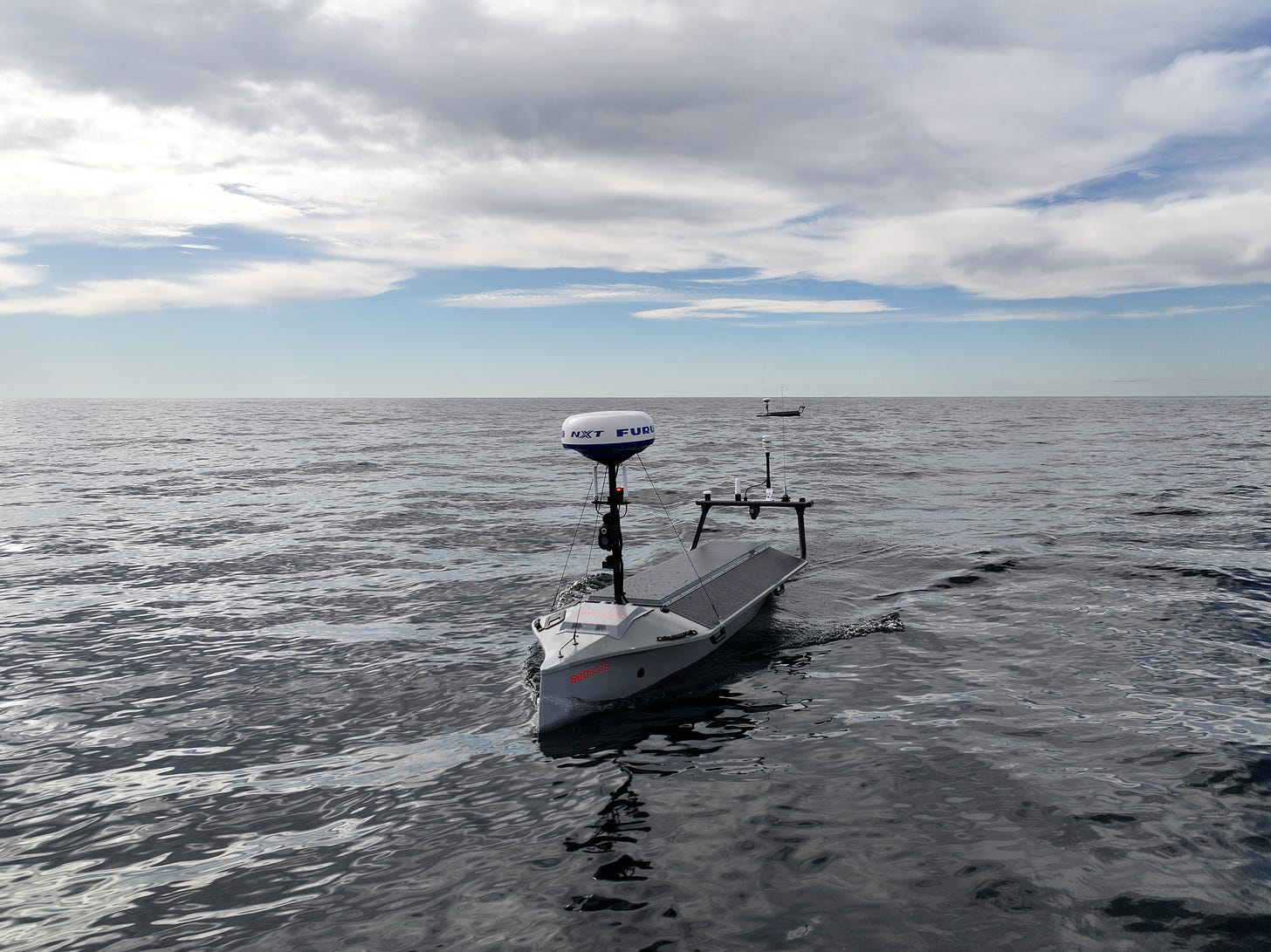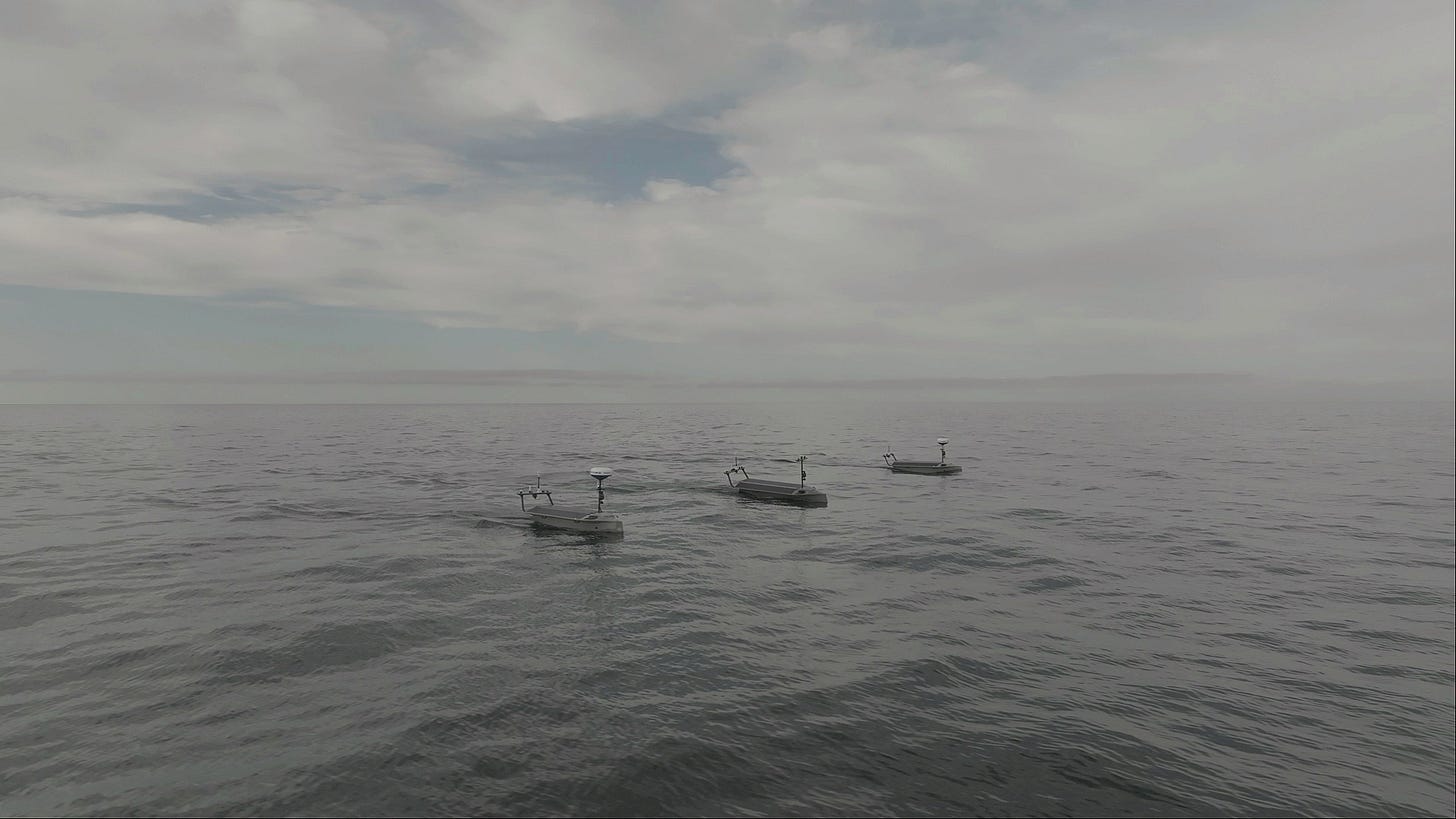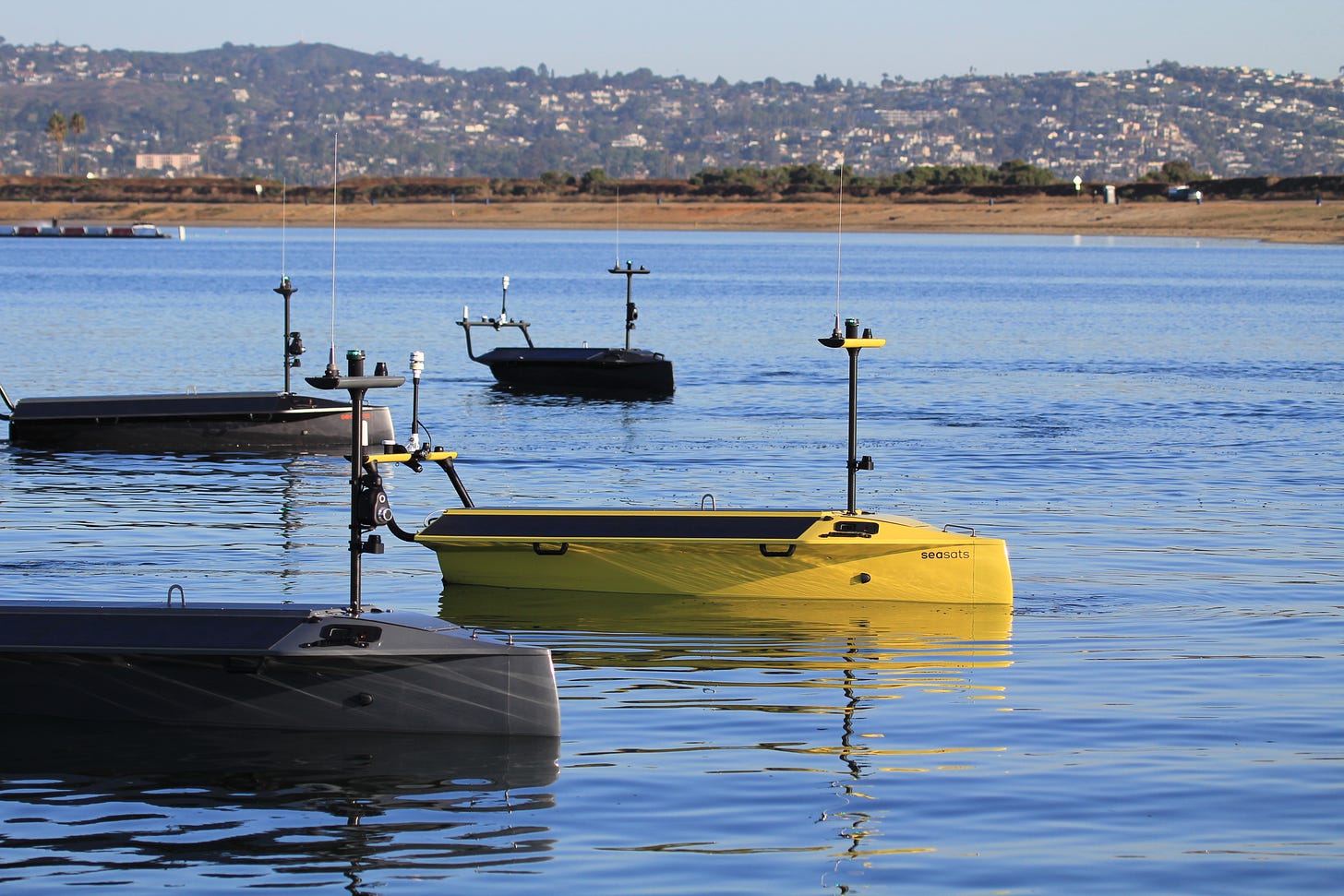A Conversation with CEO & Co-Founder Mike Flanigan
In the rapidly evolving world of autonomous platforms, Seasats, an AXV Portfolio Company, stands out as a transformative force redefining how we think about persistent ocean operations. The San Diego-based company has achieved what many thought impossible: autonomous surface vehicles operating independently for thousands of miles across open ocean, with one Lightfish platform recently completing over 6,000 miles and 150+ days at sea en route to Japan.
We recently sat down with Mike Flanigan, Seasats' CEO and co-founder, to discuss the company's groundbreaking approach to ocean autonomy, their philosophy of aggressive testing, and how they're positioning autonomous maritime systems as the ocean's equivalent to satellite constellations.
From Factory Floors to Endless Miles: The Autonomy Evolution
Most robotics companies chase the 'last mile' problem - getting packages to your doorstep. You chased what I'd call the 'endless mile' problem - keeping robots alive and thinking for thousands of miles with no WiFi, no backup, no human oversight. Were there particular technologies or insights from your automation work that made you confident this challenge could actually be solved?
"There's one school of thought, which I'm pretty partial to, which is that intelligent systems are a culmination of tons of pieces working smoothly and well together," Mike explains, drawing from his manufacturing background at companies like Tesla and P&G. "Some of my manufacturing experience was with systems that moved so fast they had to use strobe lights and computer vision, because the machine’s moving so fast that the parts are literally a blur to the human eye. So scale and complexity shouldn’t be insurmountable obstacles."
But beyond the scale, Mike identified a critical insight about integration. "The tech world as a whole - whether you're talking about communication, solar, batteries, swarm autonomy, even just better APIs, advanced software development practices – there are so many pieces out there. How you integrate all of these pieces and put together best-in-breed from as many places as possible, that's where the beauty is."
This systems thinking approach proved essential for tackling the ocean's unique challenges. "People look at our boats and say, 'Wow, they’re so autonomous, they’re amazing.' Engineers have a slightly more focused view: ’It's this new feature, this new thing.’ But really, it's the sum of about fifteen years of thinking about these problems and building little pieces and thinking about how people should execute missions on the ocean with autonomous systems."
Why the Ocean Remained Disconnected
At what point in this journey did you start questioning why the ocean - which covers 70% of our planet - remains so disconnected from this autonomous future that everyone else was focused on?
Mike points to the stark economics that reveal the ocean's unique challenge: "The sheer cost of putting a vessel with a couple people offshore is exorbitant. If you lost your sailboat 100 miles offshore and want to go tow it back, it's so expensive. $20,000 a day for a proper offshore support vessel is a bargain. People are often talking about $50,000-60,000 per day."
The reason, he explains, comes down to danger and life support systems. "In some ways the ocean is like a high mountaintop. If you fall overboard at sea and you're not tethered, you could have hypothermia and die within hours. If there's any chop at all, it becomes impossible to find people within hundreds of yards."
This creates a cascade of requirements that fundamentally change vessel design. "For example, when a DDG, a US Navy ship, is running a surveillance mission 90 percent of the ship isn’t key to the sensing. Things like life support equipment – beds, cafeterias, lifeboats, desks, etc. --, aren’t inherently needed to operate an acoustic sensor, a radar, a camera. Modern versions of those sensors are often remarkably small, things that we can fit on a Lightfish."
By removing humans from the equation, Seasats achieves dramatic efficiency gains. "We only have to worry about keeping the sensors happy. The efficiency just goes through the roof. We're getting phenomenal numbers out of the platform."
The Value of Persistent Operations
This efficiency advantage becomes most pronounced in long-duration missions. "The value prop of robots becomes extremely valuable when you're operating for more than a day offshore," Mike notes. "In those missions - weeks, months - the cost for humans just stacks terribly, and the cost for robots is extremely linear, very flat."
The company deliberately avoided the crowded short-duration market. "There are dozens, maybe 20 to 50 competitors aiming to build autonomous boats that go out for only a couple of hours. But with short missions, you're competing against someone going out in a dinghy. You're paying a maritime union guy an hourly rate - it's really not that expensive."
Learning from the First Generation: The Second Mover Advantage
How did you approach entering a market where earlier companies had already established the concept?
Mike describes Seasats' strategic positioning as benefiting from a "second mover advantage." He points to companies like Liquid Robotics' Wave Glider (acquired by Boeing for $330 million in 2016) and Saildrone (valued at around $190 million) as the "gen one platforms that showed that persistent data collection is possible from a power budget standpoint."
"But they're kind of weird products. Sort of like the BlackBerry," Mike explains. "The Wave Glider and Saildrone had lots of users and people were like, 'Oh wow, we can do this, this is possible.' They educated the market for probably seven to ten years, and they did some really impressive things. Then we came in and kept hearing, 'Oh yeah, we've used those, but they have these massive pain points.'"
This approach gave Seasats crucial market intelligence. "We had a huge advantage because we'd worked in the industry, we looked around, there was a first generation that attempted this, and we were like, 'Hey, the math makes sense, it's possible. We just need to do it better.'"
Testing Philosophy: Breaking Before Customers Do
Your stress testing approach and mission data was refreshing to see. Testing doesn't happen as often as it should in dual-use/defense tech. How does this aggressive testing philosophy drive your development?
"We always strive to be the most aggressive user," Mike explains. "When we heard from one of our early government customers that they were going to do a particularly difficult type of operation, we recreated it off the rocks off San Diego. We went and got our team, made training videos - we're going to try to do what we think they're going to do so we can send troubleshooting tips in advance."
This philosophy extends to their public demonstrations. "We want to break stuff because we're the designers. We've got the build team, the shop - we can fix, iterate, whatever. We ship field-ready products, but we don't want to have the ego of being like, 'Oh, it's done and it's perfect.' We ship upgrades, patch kits, new payload adjustments. We just try to maintain responsive, expert customer service with really fast dev teams."
The public tracking page for the Trans-Pacific mission exemplifies this transparent, test-focused approach. " We share with people what we're doing so they can see the numbers, ask questions, and understand how it works. Showing, not telling."
Addressing the Reliability Gap
A critical issue Seasats identified in the market was the gap between promises and operational reality. "There were probably close to two decades of promises in robotics that weren’t met," Mike explains. "Pre-Seasats, the promise of robots almost always came down to scale economics - 'we're going to take out the humans, it's going to get really cost effective' - but you'd add five to fifteen highly paid engineers per autonomous boat, and the boats are only spending 1% uptime on the water."
Instead of making grand promises, Seasats focused on deliverable capabilities. "We're always looking at what's the problem we can solve and go operational, go to TRL 9, go off the shelf. What can we button up and offer as a standardized, fully sellable, trainable, documentable product? Whenever possible we aim to do full development cycles within three months."
This pragmatic approach has earned recognition from government customers. "We're winning sole source contracts, and that's the government saying there's nothing else in existence that solves this problem the way that Seasats can."
Strategic Implications: Reshaping Force Posture
What does extreme endurance capability mean for maritime operations beyond just duration?
Mike sees the Trans-Pacific mission as more than a technical demonstration - it's reshaping military thinking about force posture. "There's a huge problem right now with short-range USVs - getting them to the fight. If you mass all this equipment onshore, in today’s world that’s a risk. With proliferating satellite imagery, civilian drones and X (Twitter) - open source intel is exploding."
The solution involves inverting traditional deployment models. "Vessels shouldn't be on land. As much as possible, vessels should always be at sea, distributed, the same way that aircraft carriers used to be able to hide in the ocean. Small, persistent USVs have regained that operational advantage since their small size is below satellite resolution."
Mike emphasizes the physics advantage of distributed mass: "Ask the Coast Guard or Border Patrol or DHS - it's really hard to find small boats that are doing smuggling because you need to get really close. It's finding the needle in the haystack."
This leads to Seasats' vision of distributed maritime operations. "Really, we should be thinking about the fleet of boats as your defensive or offensive asset, always out to sea, spread out in your operational area, coming back to shore for maintenance, for re-kit, for upgrades. You maintain a resilient distributed network of assets."
Beyond Surveillance: The Interceptor Challenge
You're developing a new platform called Quickfish alongside your proven Lightfish. What capability gap drove this development?
Mike describes this as addressing the "phase two" of maritime operations. "We've built the Lightfish, which is the practical answer - it's really good at being out for a long time and doing these 'remove the fog of war, tell you where every ship is' missions. The second part of that equation is to go do something about some of those - the intercept part."
The new platform addresses speed requirements that the endurance-optimized Lightfish cannot meet. "One of the compromises with Lightfish is that it's not particularly fast. It's really good at being out for a long time, but when you need to intercept something, you need different capabilities."
Mike notes the challenge of distinguishing between genuine capability and demonstration theater. "Despite a lot of press releases, things people should look for is - is the water really glassy? Are there things that are pretty clearly not particularly waterproof? There are a lot of really low TRL solutions that are brushed up to look good at demo day."
Global Operations and Market Expansion
Seasats has achieved remarkable global reach in a short time. "Right now we've got customers on every continent except Antarctica. When we look at our dashboards, it's so cool – there are boats around the globe."
This global presence is enabled by their operational model. "The boats are small - we can stick them in a box and serve customers within a couple weeks, which normally would take six months. We're good at shipping, importing, all this stuff. We ship by air rapidly.
The Satellite Constellation Model
Looking at your dual-use strategy and global operations, how do you see Seasats evolving?
"I think we're going to get to a point where ocean vehicles operate more like satellites," Mike predicts. "Right now we do global operations, but people contract us and we ship by air rapidly. "
But he envisions a more dynamic future. "As we scale, we see huge cost savings, where someone will be like, 'Hey, I want to do this thing off of Guam,' and we're like, 'Sweet, we'll retask two vehicles and they'll be there in a week and a half.' Just like retasking satellites."
This model leverages the miniaturization of payloads and the company's operational expertise. "The payloads are very small - we fly operators to locations with a travel kit that they can fly in a checked bag on a commercial airplane. I think long duration stuff will actually be out pretty much continuously for their several-year useful lifetime, just touching shore for upgrades, payload changes. Much more like a satellite constellation."
Contrarian Bets and Strategic Focus
Many hardware startups are told to focus narrowly to survive. What contrarian bet are you making about ocean robotics that conventional wisdom would consider too ambitious?
Mike acknowledges the focus imperative while explaining Seasats' broader approach. "Focus is key because you can't suck in any area. You actually need to be phenomenal in a couple areas - that's why people are buying. Usually, customers pay us for a mission that's focused around one payload - one camera or radar or electronic warfare system or sonar. But then there are six other supporting sensors that we often supply, and several hundred vehicle sensors doing health metrics and providing autonomy baseline."
The key insight is comprehensive competence. "Besides being good in those areas, particularly in this really complex world of defense and hard tech, you can't suck at any one of the pure core competencies – electronics, software, naval architecture, program management, go-to-market, network, lobbying, understanding your customer. We excel at pulling all of these disparate skillsets together in a broad but efficient organization."
Rapid Growth and Team Building
The company has grown rapidly to over 40 employees, with seven new hires in Q1 alone. "We’ve had people join from Booz Allen Hamilton, Thayer Mahan, Ocean Aero, Leidos, and more," Mike notes, highlighting the company's ability to attract talent from established defense and maritime companies.
This growth reflects the company's transition from startup to scale-up. "Things are taking off - we're hiring, scaling, we've got some major contracts. These are exciting times."
Trust in a Hype-Driven Market
How do you build trust in a space where there's significant hype around autonomous systems?
"It's a heavily trust-built space," Mike explains. "Trust with your users, trust with the network, people knowing each other and being like, 'Oh yeah, this is a company that we can trust to deliver and rely on for our missions.'"
He notes the contrast between hype and operational reality. "There's a huge amount of hype on attributable and low cost and mass right now, and that's true. But we're talking about the DOD, we're talking about serious missions. So while affordability matters, you can’t sacrifice effectiveness for budget. It’s great that a Ukrainian operator’s drone might cost only $500, but if it totally sucks, it could get them killed. Mission success still has to be top of mind.'"
Beyond the Horizon
For those interested in learning more about persistent ocean autonomy, where should they look?
"The trio I would give are, first, our website, second, our email (it'll definitely get into the hands of the leadership team if you've got questions) And third, you can find me on LinkedIn as Mike Flanigan."
Mike's confidence in Seasats' trajectory stems from their methodical approach to proving capabilities. "We founded this company on the principle that there were close to two decades of promises in robotics that just weren’t panning out. Instead of marketing a flying boat that's a submarine that can do 50 knots, we asked: what's a problem we can solve and go operational?"
The company's track record speaks to this approach. "We plan to be a billion-dollar company, and we know how to get there - from success to success to success to success."
As Seasats continues expanding their global operations and developing new platforms, they're not just building autonomous boats - they're pioneering a new model for how humans interact with the ocean. With proven technology and ambitious plans for satellite-like operations, Seasats is positioning itself at the forefront of the maritime autonomous revolution.
Editor's Note: Mike Flanigan is the CEO and co-founder of Seasats, an AXV portfolio company pioneering persistent ocean autonomy. With 40 employees and vehicles operating on every continent except Antarctica, the company continues its rapid growth. Seasats represents the kind of transformative dual-use innovation AXV is committed to supporting - technology that addresses fundamental operational challenges while creating new possibilities in both defense and commercial maritime applications.
For those interested in learning more about Seasats and their autonomous ocean platforms, visit seasats.com, where you can track their vehicles in real-time and see their technology in action.










